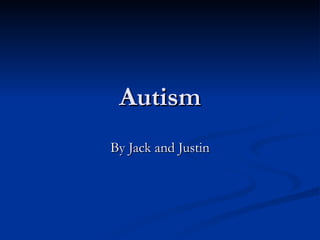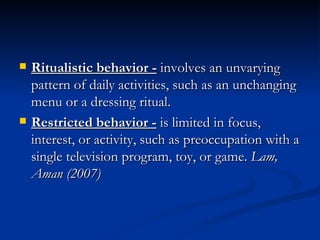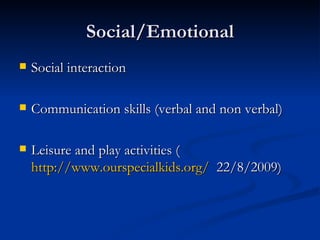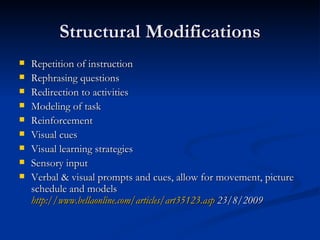Autism
- 1. Autism By Jack and Justin
- 2. What is Autism? Autism is a brain development disorder (Geschwind DH (2008). ) First appears during infancy or childhood Generally follows a steady course without remission ( World Health Organization (2006). )
- 3. Causes The causes of autism are still unclear Probably caused by a combination of genetic and environmental factors. (Jo Rudy, 2009)
- 4. Causes Two theories link autism and vaccines. MMR (Mumps-Measles-Rubella) vaccine may cause intestinal problems leading to the development of autism. The second theory suggests that a mercury-based preservative called thimerosal, used in some vaccines, could be connected to autism. (Jo Rudy, 2009)
- 5. Symptoms Impairments in social interaction Impairments in communication Restricted interests Repetitive behavior. ( Filipek, Accard, Baranek 1999)
- 6. Characteristics Stereotypy - is repetitive movement, such as hand flapping, making sounds, head rolling, or body rocking. Compulsive behavior - is intended and appears to follow rules, such as arranging objects in a stacks or lines. Sameness - is resistance to change; for example, insisting that the furniture not be moved or refusing to be interrupted.
- 7. Ritualistic behavior - involves an unvarying pattern of daily activities, such as an unchanging menu or a dressing ritual. Restricted behavior - is limited in focus, interest, or activity, such as preoccupation with a single television program, toy, or game. Lam, Aman (2007)
- 8. Types of Autism Autistic Disorder Asperger's Disorder Pervasive Developmental Disorder-Not Otherwise Specified Rett's Disorder Childhood Disintegrative Disorder (American Psychiatric Association 1994)
- 10. Social/Emotional Social interaction Communication skills (verbal and non verbal) Leisure and play activities ( http://www.ourspecialkids.org/ 22/8/2009)
- 11. Physical Repeated body movements Hand flapping Rocking ( ( http:// www.ourspecialkids.org / 22/8/2009))
- 12. Cognitive Difficulty with the mental lives of others; autistic children typically treat others, including caregivers, as "objects." Have little understanding that others may have different beliefs about the world from their own Baron-Cohen et. al., 1985 Currie, 1995 http://www.stanford.edu/group/SHR/4-1/text/currie.commentary.html 24/8/2009.
- 13. Language Cause of speech and language problems in autism is unknown difficulties result from a variety of conditions that occur either before, during, or after birth affecting brain development. http://autism.emedtv.com/autism/language-development-in-autistic-children.html 24/8/2009
- 14. Structural Modifications Check the location of the children frequently Make sure all poisonous items are stored securely. Attempt to offer the child a variety of other materials to play with, such as play dough, finger paints. http://www.spiritlakeconsulting.com/COPT/earlychildhood/classmod2.html 24/8/2009
- 15. Structural Modifications Repetition of instruction Rephrasing questions Redirection to activities Modeling of task Reinforcement Visual cues Visual learning strategies Sensory input Verbal & visual prompts and cues, allow for movement, picture schedule and models http://www.bellaonline.com/articles/art35123.asp 23/8/2009
- 16. Modifications to Program Group time - Allow children to learn the social rules and gradually be introduced to group time routines. Outdoor play - Check the location of the children frequently. Make sure they are wearing hat, gloves and other appropriate clothing for the weather.
- 17. Modification to program Play with others : Imagination Turn taking Building relationships Imitation Appropriate language Tolerance to a variety of ways to play with toys Reciprocal interaction Most of all to have fun.
- 18. Resources I LOVE MY BROTHER: A PRESCHOOLER'S VIEW OF LIVING WITH A BROTHER WHO HAS AUTISM (2001). By Connor Sullivan. Phat Art 4 Publishing. Aimed at preschoolers. ISBN: 0970658117 (hardcover, 24 pages) KEISHA'S DOORS (2005). By Marvie Ellis. Part of the series An Autism Story Book . First in series; Bilingual in Spanish and English; Spanish title is Las Puertas de Keisha. Speech Kids Texas Press. For ages 4 through 8. http://www.speechkidstexaspress.com/; ISBN: 1933319003 (hardcover, 32 pages) INCLUSIVE PROGRAMMING FOR ELEMENTARY STUDENTS WITH AUTISM . (1999). By Sheila Wagner. The Council for Exceptional Children (CEC), 1110 North Glebe Road, Suite 300, Arlington VA 22201. Winner of the Autism Society of America’s books of the year award in 2001. Voice phone: 703-620-3660; TTY phone: 866-915-5000; fax: 703-264-9494. E-mail: service@cec.sped.org; Website: http://www.cec.sped.org WHY CAN'T CHARLIE TALK? (2004). By Debbi Spencer. Perth: Miss Muffet Books. For ages 4 through 8. http://www.q-net.net.au/~deevee/MissMuffetBooks.htm; ISBN: 0646437437 (paperback, 30 pages). http://new.gbgm-umc.org/umcor/media/pdfs%20health/autismresources.pdf 23/8/2009
- 19. Partnership with Families It is incredibly important that there is constant communication with the families involved. Caregivers can inform us as about the child’s routines at home. This makes the transitions through the day and settling in easier for the child.
- 20. Partnership with Families Topics that should be covered Their daily routine Comfort items If they have any rituals at rest times.
- 21. Partnership with Families Make the centre seem as familiar and comforting to the child as possible. Comfort items from home Pictures of their family Having communication between the child at the centre and their parents Having a open door policy Converse with the child about their home life, their interests and familiar topics.
- 22. References Filipek PA, Accardo PJ, Baranek (1999). "The screening and diagnosis of autistic spectrum disorders". J Autism Dev Disord 29 (6): 439–84. http:// en.wikipedia.org/wiki/Autism (First Accessed 23/8/2009) Geschwind DH (2008). "Autism: many genes, common pathways?". Cell 135 (3): 391–5. http:// en.wikipedia.org/wiki/Autism (First Accessed 23/8/2009) http://autism.emedtv.com/autism/language-development-in-autistic-children.html (first accessed 23/8/2009) http:// books.google.com/books?id =XQzIIcu7wxcC&pg=PA268&lpg=PA268&dq= group+time+activities+autism&source = bl&ots =JIz57iEjoF&sig=D3Qkv6PDO-4_qxpNv6cZzclzA68&hl= en&ei =DyWSSru-GsKJkQXakaS7Cg&sa= X&oi = book_result&ct = result&resnum =2#v= onepage&q =group%20time%20activities%20autism&f=false (first accessed 23/8/2009) http://new.gbgm-umc.org/umcor/media/pdfs%20health/autismresources.pdf (first accessed 23/8/2009) http://www.bellaonline.com/articles/art35123.asp (first accessed 23/8/2009) Lam KSL, Aman MG (2007). " The Repetitive Behavior Scale-Revised: independent validation in individuals with autism spectrum disorders ". J Autism Dev Disord 37 (5): 855–66 Lisa Jo Rudy “What Causes Autism?” http:// autism.about.com/od/whatisautism/p/autismcauses.htm (first accessed 23/8/2009) World Health Organization (2006). "F84. Pervasive developmental disorders". International Statistical Classification of Diseases and Related Health Problems (10th ( ICD-10 ) ed.). http:// en.wikipedia.org/wiki/Autism (First Accessed 23/8/2009)





















